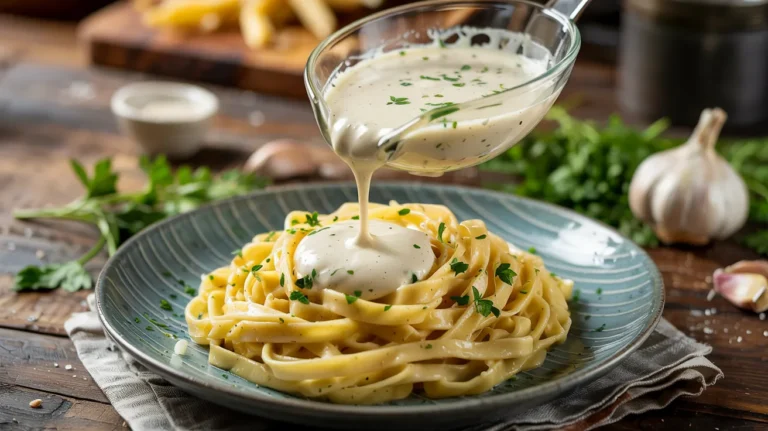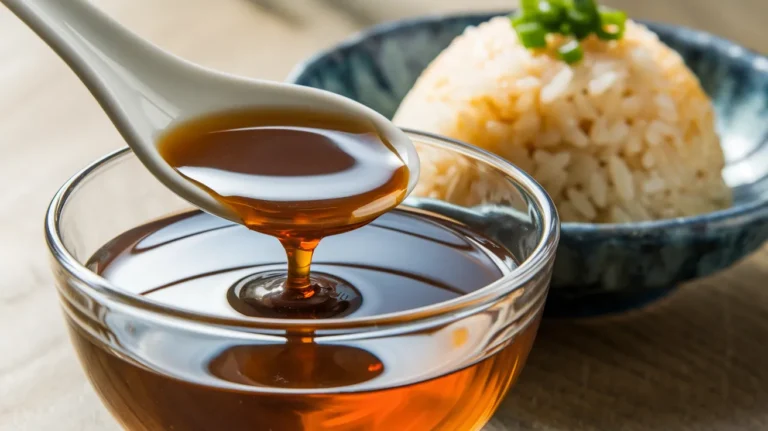This silky sauce for lemon ricotta ravioli creates the perfect balance of buttery richness and bright citrus notes. Our foolproof technique guides beginners through each step, ensuring your sauce for lemon ricotta ravioli turns out restaurant-quality every single time.
SERVES: 4 | PREP: 10 MIN | COOK: 15 MIN | TOTAL: 25 MIN
Ingredients
| For the Sauce | Amount |
|---|---|
| Unsalted butter | 6 tablespoons |
| Fresh lemon juice | 3 tablespoons |
| Lemon zest | 2 teaspoons |
| Heavy cream | 1/2 cup |
| Fresh sage leaves | 12 leaves |
| Garlic cloves | 2 cloves, minced |
| White wine | 1/4 cup |
| Parmesan cheese | 1/2 cup, grated |
| Salt | 1 teaspoon |
| Black pepper | 1/4 teaspoon |
| For Serving | Amount |
|---|---|
| Lemon ricotta ravioli | 1 pound, fresh or frozen |
| Pine nuts | 2 tablespoons, toasted |
| Fresh parsley | 2 tablespoons, chopped |
Detailed Step-by-Step Instructions for Beginners
Phase 1: Essential Preparation (8-10 minutes)
1. Set up your cooking station completely before touching the stove. Place all ingredients within arm’s reach of your cooking area. This sauce for lemon ricotta ravioli moves quickly once you start, and having everything ready prevents disasters.
2. Fill a large pot with water (about 6 quarts) and place it on your largest burner over high heat. Add 2 tablespoons salt to the water. The water needs to come to a rolling boil, which takes 10-15 minutes depending on your stove.
3. Prepare your lemons properly by washing them under cool water first. Using a microplane grater (the small holes work best), grate only the bright yellow outer skin. Stop immediately when you see white underneath – that’s the bitter pith. You need 2 teaspoons total. Cut lemons in half and squeeze 3 tablespoons fresh juice through a fine strainer to remove seeds.
4. Prep your garlic carefully by removing papery outer skins. Place the flat side of your knife over each clove and press down firmly until you hear a crack. The skin will slide off easily. Mince into tiny, uniform pieces about 1/8-inch in size. Larger pieces will burn and create bitter flavors.
5. Measure your sage leaves by gently washing them and patting completely dry with paper towels. Any water drops will cause dangerous spattering when they hit hot butter. Count out exactly 12 medium leaves.
6. Toast pine nuts in a dry skillet over medium heat for 2-3 minutes, stirring constantly. They’ll turn golden brown and smell nutty. Remove immediately to a plate – they continue cooking in the hot pan even after removing from heat.
Phase 2: Building Your Sauce Base (5-7 minutes)
7. Choose the right pan size – use a 10 or 12-inch skillet with high sides. Too small and ingredients will crowd; too large and butter will spread too thin and burn. Place over medium-low heat for 1 minute to warm gradually.
8. Add your first portion of butter – exactly 2 tablespoons of cold butter cut into small cubes. Watch it melt slowly and completely. The butter should bubble gently but never turn brown. If it starts browning, your heat is too high – remove pan from burner for 30 seconds.
9. Add minced garlic when butter stops bubbling and cook for exactly 45 seconds. Stir constantly with a wooden spoon. The garlic should smell fragrant and turn slightly golden but never brown. Brown garlic tastes bitter and ruins the entire sauce.
10. Pour white wine carefully down the side of the pan (not directly onto hot garlic). It will bubble and steam vigorously – this is normal. Let it simmer for 2-3 minutes until reduced by half. You’ll know it’s ready when you can draw a line through the liquid with your spoon and it takes 2 seconds to fill back in.
11. Add sage leaves one at a time using tongs or a fork. They’ll sizzle and curl slightly. Cook for 1 minute exactly – they should darken slightly and become aromatic but not crispy. Overcooked sage turns bitter.
Phase 3: Creating the Perfect Emulsion (6-8 minutes)
12. Reduce heat to the lowest setting on your stove. This step is crucial – high heat will break your sauce and make it greasy. Add remaining 4 tablespoons cold butter one tablespoon at a time. Cut each tablespoon into 3-4 small pieces for faster melting.
13. Whisk constantly while adding butter using a balloon whisk if you have one. Each piece should melt completely before adding the next. The mixture will look creamy and smooth, not oily. This process takes patience – rushing will ruin everything.
14. Check your emulsion by lifting your whisk. The sauce should coat it evenly like thick cream. If it looks oily or separated, remove from heat immediately and whisk in 1 tablespoon cold butter to fix it.
15. Add heavy cream very slowly – pour it in a thin stream while whisking constantly. The sauce will become silky and lighter in color. If it looks lumpy, whisk more vigorously off the heat for 30 seconds.
16. Test consistency by dipping a spoon and running your finger across the back. The line should stay clear for 3-4 seconds before filling in. This means your sauce will coat pasta properly.
Phase 4: Final Seasoning and Assembly (3-4 minutes)
17. Add lemon juice gradually – start with 2 tablespoons and taste. The sauce should be bright but not puckering. Add remaining tablespoon if needed. Too much lemon will break the cream, so go slowly.
18. Stir in lemon zest gently using a spoon, not the whisk. Whisking can make zest stringy. The zest provides intense lemon flavor that juice alone cannot.
19. Season with salt carefully – start with 1/2 teaspoon and taste. Remember that Parmesan cheese adds saltiness too. Add black pepper to taste – freshly ground works best.
20. Remove completely from heat before adding cheese. Hot temperatures make Parmesan clumpy. Stir in 1/4 cup grated Parmesan and let residual heat melt it smoothly.
Phase 5: Cooking and Combining (4-5 minutes)
21. Check your pasta water – it should be at a rolling boil with large bubbles breaking the surface constantly. Add ravioli carefully to avoid splashing. Fresh ravioli cooks in 3-4 minutes; frozen takes 5-6 minutes.
22. Test ravioli doneness by removing one piece with a slotted spoon after minimum cooking time. It should be tender but not mushy. The filling should be hot throughout.
23. Reserve pasta water before draining – use a measuring cup to scoop 1/2 cup of the starchy cooking water. This liquid gold helps bind sauce to pasta.
24. Drain ravioli gently in a colander, but don’t shake vigorously. Delicate ravioli can burst if handled roughly.
25. Combine immediately by adding drained ravioli to your sauce pan off the heat. Gently fold together using a large spoon and silicone spatula. Add pasta water 1 tablespoon at a time if sauce seems too thick.
Perfecting Your Sauce for Lemon Ricotta Ravioli – Chef’s Notes
• Temperature is Everything: Keep heat low throughout the entire cooking process. High temperatures break butter sauces and make them greasy instead of creamy.
• Butter Quality Matters: Use high-quality unsalted butter for the best sauce for lemon ricotta ravioli. Salted butter can make the final dish too salty and mask delicate flavors.
• Fresh Ingredients Only: This sauce for lemon ricotta ravioli depends on fresh lemon juice and zest. Bottled juice lacks the bright flavor that makes this sauce special.
• Timing Coordination: Start your sauce when pasta water begins boiling. Both components should finish simultaneously for optimal temperature and texture.
Nutrition Information (Per Serving)
- Calories: 385
- Protein: 12g
- Carbohydrates: 8g
- Fat: 28g
- Fiber: 1g
- Sodium: 420mg
Creative Variations for Your Sauce for Lemon Ricotta Ravioli
Herb Garden Enhancement
Replace sage with equal amounts fresh thyme and rosemary for an earthy twist. This variation pairs beautifully with techniques from 4 cheese ravioli sauce preparations.
Mediterranean Caper Addition
Stir in 2 tablespoons drained capers and 1 tablespoon fresh dill during the final seasoning step for briny complexity.
Pancetta Upgrade
Crisp 3 ounces diced pancetta before adding garlic for smoky depth that rivals lobster ravioli sauce richness.
Green Goddess Version
Wilt 2 cups baby spinach into the finished sauce for added nutrition and vibrant color.
Storage & Reheating Your Sauce
Refrigerator Storage: Store leftover sauce for lemon ricotta ravioli in an airtight container for up to 3 days. The butter will solidify when cold – this is completely normal.
Proper Reheating: Warm gently in a small saucepan over the lowest heat setting, whisking in 1-2 tablespoons pasta water or cream to restore silky texture.
Freezing Reality: This butter-based sauce doesn’t freeze well because dairy separates when thawed, creating an unappetizing texture.
Make-Ahead Strategy: Prepare all ingredients up to 4 hours ahead, but cook the sauce fresh for best results.

Troubleshooting Your Sauce for Lemon Ricotta Ravioli
Problem: Sauce looks greasy and separated Solution: Remove from heat immediately and whisk in 2 tablespoons cold butter or cream vigorously until smooth again.
Problem: Sauce is too thick to coat pasta Solution: Thin with warm pasta water, 1 tablespoon at a time, whisking constantly until desired consistency.
Problem: Sauce tastes overly acidic Solution: Balance with 1 tablespoon additional butter and a tiny pinch of sugar to mellow harsh lemon notes.
Problem: Garlic burned and created bitter flavor Solution: Unfortunately, you must start over from the garlic step. Burnt garlic cannot be fixed and ruins the entire base.
Problem: Sauce won’t stick to ravioli Solution: Add ravioli to sauce pan off heat, toss gently, and add pasta water gradually until sauce clings properly.
Equipment Essentials
- Large skillet or sauté pan (10-12 inch diameter)
- Balloon whisk for smooth emulsions
- Microplane grater for perfect lemon zest
- Large pasta pot (6+ quart capacity)
- Measuring cups and spoons (accurate measurements crucial)
- Fine-mesh strainer for pasta water and lemon juice
- Wooden spoon for gentle stirring
- Slotted spoon for testing ravioli
Organized Shopping List
Dairy Section
- Unsalted butter (1 stick minimum)
- Heavy cream (small 8oz container)
- Fresh Parmesan cheese wedge (avoid pre-grated)
Produce Section
- Fresh lemons (2 large for juice and zest)
- Fresh sage (1 small package)
- Fresh garlic bulb
- Fresh flat-leaf parsley
Pantry & Wine
- Dry white wine (cooking wine acceptable)
- Pine nuts (small bag)
- Sea salt and black peppercorns
Frozen/Fresh Pasta
- Lemon ricotta ravioli (1 pound package)
Master These Success Secrets
1. Temperature Control: Keep heat low when making this sauce for lemon ricotta ravioli. High heat breaks emulsions and creates greasy disasters.
2. Starchy Water Magic: The cloudy pasta cooking water contains natural starches that help your sauce cling to each ravioli perfectly.
3. Perfect Timing: Coordinate sauce and pasta cooking so both finish simultaneously. Cold sauce won’t coat properly, and reheating breaks the emulsion.
4. Gradual Seasoning: Build flavors slowly, tasting after each addition. You can always add more lemon or salt, but you cannot remove excess.
5. Immediate Service: This delicate sauce for lemon ricotta ravioli is meant to be enjoyed hot. It thickens and loses silkiness as it cools, so serve immediately for best results.




